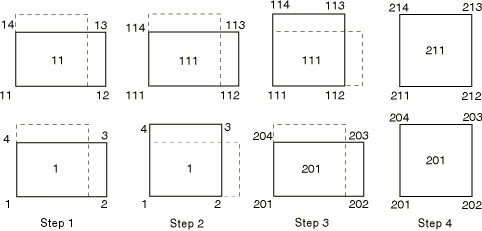Transferring results between Abaqus/Explicit and Abaqus/Standard
Elements tested
C3D8R
CPE4R
S4R
Problem description
The verification problems outlined in this section test the addition and the removal of elements in a sequential import analysis. The problems also test the application of initial stresses and velocities on imported elements that can be applied only under certain conditions (see Transferring Results between Abaqus/Explicit and Abaqus/Standard).
The finite element model in these verification problems consists of two elements that are not connected to each other, as shown in Figure 1. The elastic, elastic-plastic, hyperelastic, and hyperelastic foam material models are used.

Each analysis, for a given combination of an element type and material model, consists of four steps, with the first step being an Abaqus/Explicit analysis. In this step the two elements, 1 and 11, are loaded in tension for all material models except for the hyperelastic foam model, where the elements are loaded in compression.
The second step is an import analysis, with the results being imported into Abaqus/Standard. In this case the results of element 1 only are imported with the reference configuration updated and the material state not imported. Since the material state is not imported, initial stresses can be prescribed for the imported element. In addition, a new element, 111, is defined in the import analysis and subjected to loading in tension (compression when the hyperelastic foam material model is used).
The third step is another import analysis, with the results now being imported into Abaqus/Explicit from the previous Abaqus/Standard analysis. The material state is imported, and the reference configuration is updated. The results for element 111 are imported into the Abaqus/Explicit analysis, while the results for element 1 are not imported. Initial velocities are prescribed at the nodes of the imported element. A new element, 201, is defined in this import analysis and subjected to a tensile load (compressive load when the hyperelastic foam material model is used).
The results of element 201 at the end of the third step are then imported into Abaqus/Standard, with the reference configuration updated and the material state not imported. A new element, 211, is defined in this step. When the reference configuration is updated and the material state is not imported, the nodal definitions and the element connectivities of the imported nodes and elements can be redefined. This feature is tested in the fourth step by modifying the connectivity of element 201 and redefining nodes 203 and 204.
Results and discussion
The tests performed in this section verify that elements can be successfully added and removed in a sequential import analysis.
Input files
- xs_x_c3d8r_ar_el.inp
-
First Abaqus/Explicit analysis.
- xs_s_c3d8r_ar_el.inp
-
First Abaqus/Standard analysis.
- sx_x_c3d8r_ar_el.inp
-
Second Abaqus/Explicit analysis.
- sx_s_c3d8r_ar_el.inp
-
Second Abaqus/Standard analysis.
- xs_x_cpe4r_ar_el.inp
-
First Abaqus/Explicit analysis.
- xs_s_cpe4r_ar_el.inp
-
First Abaqus/Standard analysis.
- sx_x_cpe4r_ar_el.inp
-
Second Abaqus/Explicit analysis.
- sx_s_cpe4r_ar_el.inp
-
Second Abaqus/Standard analysis.
- xs_x_s4r_ar_el.inp
-
First Abaqus/Explicit analysis.
- xs_s_s4r_ar_el.inp
-
First Abaqus/Standard analysis.
- sx_x_s4r_ar_el.inp
-
Second Abaqus/Explicit analysis.
- sx_s_s4r_ar_el.inp
-
Second Abaqus/Standard analysis.
- xs_x_c3d8r_ar_ep.inp
-
First Abaqus/Explicit analysis.
- xs_s_c3d8r_ar_ep.inp
-
First Abaqus/Standard analysis.
- sx_x_c3d8r_ar_ep.inp
-
Second Abaqus/Explicit analysis.
- sx_s_c3d8r_ar_ep.inp
-
Second Abaqus/Standard analysis.
- xs_x_cpe4r_ar_ep.inp
-
First Abaqus/Explicit analysis.
- xs_s_cpe4r_ar_ep.inp
-
First Abaqus/Standard analysis.
- sx_x_cpe4r_ar_ep.inp
-
Second Abaqus/Explicit analysis.
- sx_s_cpe4r_ar_ep.inp
-
Second Abaqus/Standard analysis.
- xs_x_s4r_ar_ep.inp
-
First Abaqus/Explicit analysis.
- xs_s_s4r_ar_ep.inp
-
First Abaqus/Standard analysis.
- sx_x_s4r_ar_ep.inp
-
Second Abaqus/Explicit analysis.
- sx_s_s4r_ar_ep.inp
-
Second Abaqus/Standard analysis.
- xs_x_c3d8r_ar_he.inp
-
First Abaqus/Explicit analysis.
- xs_s_c3d8r_ar_he.inp
-
First Abaqus/Standard analysis.
- sx_x_c3d8r_ar_he.inp
-
Second Abaqus/Explicit analysis.
- sx_s_c3d8r_ar_he.inp
-
Second Abaqus/Standard analysis.
- xs_x_cpe4r_ar_he.inp
-
First Abaqus/Explicit analysis.
- xs_s_cpe4r_ar_he.inp
-
First Abaqus/Standard analysis.
- sx_x_cpe4r_ar_he.inp
-
Second Abaqus/Explicit analysis.
- sx_s_cpe4r_ar_he.inp
-
Second Abaqus/Standard analysis.
- xs_x_s4r_ar_he.inp
-
First Abaqus/Explicit analysis.
- xs_s_s4r_ar_he.inp
-
First Abaqus/Standard analysis.
- sx_x_s4r_ar_he.inp
-
Second Abaqus/Explicit analysis.
- sx_s_s4r_ar_he.inp
-
Second Abaqus/Standard analysis.
- xs_x_c3d8r_ar_hf.inp
-
First Abaqus/Explicit analysis.
- xs_s_c3d8r_ar_hf.inp
-
First Abaqus/Standard analysis.
- sx_x_c3d8r_ar_hf.inp
-
Second Abaqus/Explicit analysis.
- sx_s_c3d8r_ar_hf.inp
-
Second Abaqus/Standard analysis.
- xs_x_cpe4r_ar_hf.inp
-
First Abaqus/Explicit analysis.
- xs_s_cpe4r_ar_hf.inp
-
First Abaqus/Standard analysis.
- sx_x_cpe4r_ar_hf.inp
-
Second Abaqus/Explicit analysis.
- sx_s_cpe4r_ar_hf.inp
-
Second Abaqus/Standard analysis.
- xs_x_s4r_ar_hf.inp
-
First Abaqus/Explicit analysis.
- xs_s_s4r_ar_hf.inp
-
First Abaqus/Standard analysis.
- sx_x_s4r_ar_hf.inp
-
Second Abaqus/Explicit analysis.
- sx_s_s4r_ar_hf.inp
-
Second Abaqus/Standard analysis.